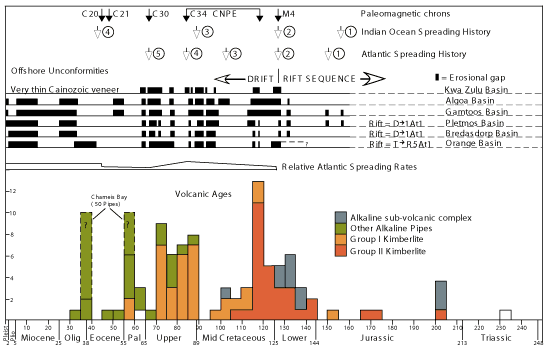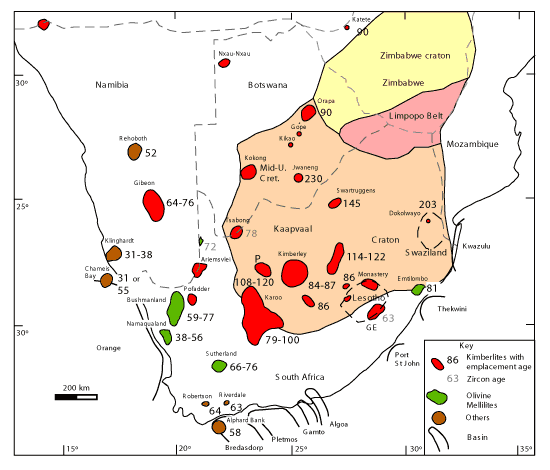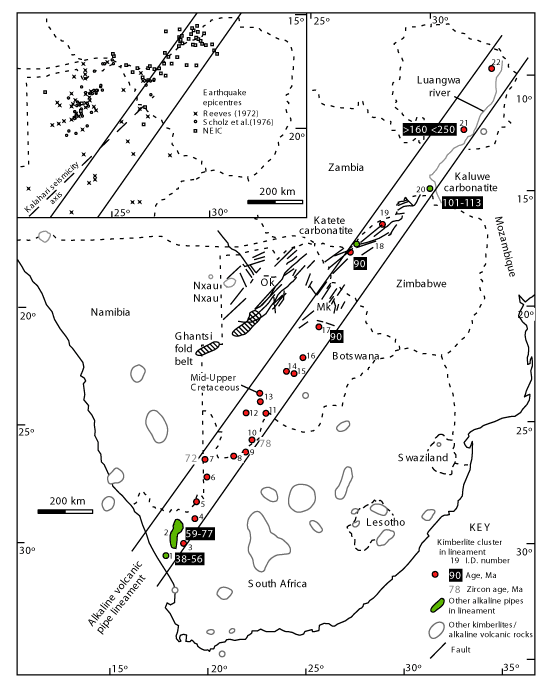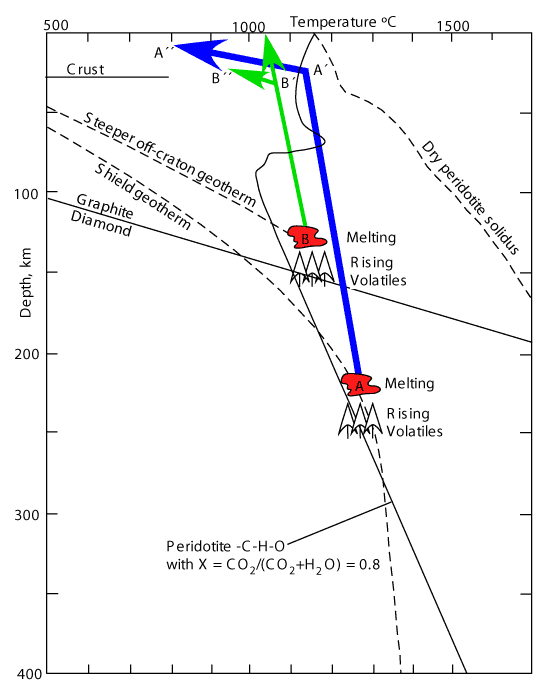 |
Controls of post-Gondwana alkaline volcanism in southern Africa |
Andrew
Moore1,2,
Thomas
Blenkinsop3 &
F. Cotterill4
1Department of Geology,
Rhodes University, Grahamstown 6140, South Africa
2African
Queen Mining Ltd., Box 66, Maun Botswana, andy.moore@info.bw
3School
of Earth and Environmental Sciences, James Cook University,
Townsville, QLD4811, Australia, Thomas.Blenkinsop@jcu.edu.au (corresponding
author)
4AEON - African Earth Observatory
Network, and Department of Geological Sciences,
and Department of Molecular and Cell Biology, University
of Cape Town, Rondebosch 7701, South Africa, fenton.cotterill@uct.ac.za
The simplicity and elegance of the
original “plume” concept
to account for intra-plate volcanism (Wilson,
1963; Morgan, 1972) undoubtedly underpinned
an early widespread acceptance of the model. A consequence
was that alternatives, such as the Membrane Tectonics
concept of Turcotte & Oxburgh (1973),
failed to attract significant support, and plumes continue
to be invoked as a trigger for volcanic activity, despite
increasing criticism of the model. Here we summarize
aspects of the timing and distribution of post-Gondwana
alkaline volcanism in southern Africa which are not
readily reconciled with a mantle plume trigger.
Figure 1 shows emplacement ages of post-Gondwana alkaline
volcanic pipes and sub-volcanic pipe clusters in southern
Africa. The dataset used excludes radiometric dates
for single zircons, as these reflect igneous events
in the mantle which may predate the emplacement age
by 10 Ma or more, and thus only place an upper limit
on the actual liming of volcanic activity (Moore
et al.,
2008). Collectively, the emplacement ages
summarized in Figure 1 show that southern Africa experienced
sporadic alkaline volcanism during the Triassic and
Jurassic. The beginning of the Cretaceous (145.5 Ma)
marked the start of an episode of major kimberlite
volcanic activity on the sub-continent that continued
into the mid-Cretaceous (~95 Ma), with a pronounced
peak at 117 Ma. Most of the kimberlites emplaced during
this period belong to the Group II population recognized
by Smith (1983). Following a short (~5 Ma)
period of quiescence, there was a renewed episode of
volcanism in the Upper Cretaceous (~90-70 Ma), dominated
by the emplacement of the Group I kimberlite suite
of Smith (1983). This Upper Cretaceous volcanic
episode was followed by a short (~5-10 Ma) period of
relative quiescence (~70 to 60 Ma) and thereafter a
minor though distinct early Tertiary period of activity
(~60-55 Ma). The latter includes the Bushmanland olivine
melilitites and para-kimberlites in the west of South
Africa (Figure 2).
The Eocene was characterized by
volcanic quiescence on the sub-continent, and was followed
by a Late Eocene/Oligocene volcanic event, represented
by a small number of pipes from a number of centres
in the west of the country, possibly including the
Chameis Bay pipes. These episodes of alkaline volcanism
in southern Africa can be closely correlated with continent
wide volcanic activity in the early Cretaceous (135-110
Ma) Late Cretaceous (90-70 Ma), and Late Palaeogene
(~40 Ma; Bailey, 1993).

Figure 1: A summary
of volcanic ages, offshore unconformities (data from
McMillan,
2003) and Atlantic spreading histories (Nürenberg & Muller,
1991). CNPE = Cretaceous Normal Polarity Episode. Indian
Spreading History (from McMillan, 2003 and Reeves & de
Wit, 2000): 1 – Initial rifting between
Africa and Antarctica; 2 – Commencement of spreading;
3 & 4: Changes in Indian spreading regime recognized
by Reeves & de Wit (2000). Atlantic spreading
history (from Nürnberg & Muller,
1991; Dingle & Scrutton, 1974): 1- Rifting
extends into southern Atlantic ocean; 2 – Commencement
of opening of Atlantic (drift sequence) (M4); 3: Estimated
time of separation of Falkland plateau and Agulhas
bank, based on assumed spreading rates; 4 – Major
shift in pole of rotation of African/South American
plates; 5 – Beginning of progressive shift in
pole of rotation of African/South American plates.
Note that Reeves & de Wit (2000) suggested
that Atlantic spreading commenced earlier (~136 Ma)
than the timing inferred by Nürnberg & Muller (1991)
and McMillan (2003) (~127 Ma). From Moore
et al. (2008). Click here or
on Figure for enlargement.

Figure 2: Distribution, and representative
ages of alkaline volcanic pipes in southern Africa.
While zircon ages have been included where other
data are unavailable, these only provide an upper
limit on the timing of emplacement, as discussed
in the text. From Moore
et al. (2008). Click here or
on Figure for enlargement.
The regional distribution of post-Gondwana
alkaline pipes across southern Africa is illustrated
in Figure 2, together with representative ages. Group
I and Group II kimberlites were erupted in the same
general areas in the interior of the country, but at
different times. Subsequent volcanic events define
an overall trend of younging from the interior towards
the continental margins of southern Africa. Superimposed
on these patterns is a major igneous lineament extending
from NE Zambia to the west coast of South Africa, defined
by alkaline pipe clusters that become younger towards
the southwest (Figure 3). There is also a very systematic
trend of decreasing average bulk rock MgO contents
and maximum Forsterite content of olivine phenocrysts
in volcanic pipe clusters from the interior to the
margins of the sub-continent (Moore et al.,
2008).

Figure 3: The alkaline volcanic
pipe lineament that extends from the west coast of
South Africa into the Zambezi and Luangwa rifts of
Zimbabwe and Zambia. The dates available for volcanic
rocks on the lineament indicate a systematic increase
in age to the NE. Note that the zircon ages only
provide an upper limit on the emplacement age, as
discussed in the text. The inset shows earthquake
epicentres from Reeves (1972) and a microearthquake
study by Scholz et al. (1976). The Kalahari seismicity
axis, approximately coincident with the lineament,
was identified by Reeves (1972). Epicentres to the
north west of the lineament in Botswana lie in the
Okavango Rift Zone (Kinabo et al., 2007). Faults
are marked in northern Botswana and the Mid Zambezi
valley of Zimbabwe and Zambia from Scholz et al.
(1976), Bailleuil (1979), and Kinabo et al. (2007).
Ok = Okavango Delta; Mk = Makgadigadi Pans.
Key to pipe clusters: 1. Namaqualand
olivine melilitites; 2. Bushmanland olivine melilitites;
3. post-Karoo diatremes; 4. Pofadder kimberlites;
5. Ariemsvlei kimberlites; 6. Noeniputs kimberlite;
7. Rietfontein kimberlite; 8. Southern Botswana kimberlites;
9. Kolongkweneng kimberlites; 10. Tsabong-Molopo
kimberlites; 11. Khekhe fissure; 12. Mabuasehube
kimberlites; 13. Kokong kimberlites 14. Kikao kimberlites;
15. Khutse kimberlites; 16. Gope kimberlites; 17.
Orapa 19: Binga kimberlites and Katete carbonatite;
20. Sengwa kimberlites; 21. lower Luangwa (Kaluwe)
carbonatites; 22. Kapamba lamproites; 23. Mushinje
kimberlites; 24. Isoka kimberlites. From Moore
et al. (2008). Click here or
on Figure for enlargement.
Basins on the margins of southern
Africa are characterized by episodic sedimentation
patterns, with series of major unconformities, reflecting
episodes of continental tectonic instability, separated
by periods of uninterrupted sedimentation (McMillan,
2003; Figure 1). The initiation of each major set of
unconformities can be correlated with plate reorganizations,
and shows a systematic relationship to episodes of
volcanic activity. Thus, disruption of Gondwana commenced
with rifting in the east of Southern Africa at about
156-150 Ma, and deposition of a thick offshore rift
sequence (McMillan,
2003). This preceded an Early Cretaceous volcanic episode
by some 10 Ma (Figure 1). Ocean opening in the Atlantic
and Indian commenced at ~126 Ma, roughly 10 Ma prior
to the peak in alkaline activity at 117 Ma. A series
of major offshore unconformities mark the early “drift” sequence
in the sedimentary sequences in the basins on the continental
shelf (Figure 1). An abrupt decline in alkaline volcanism
on the sub-continent at ~115 Ma heralded a period or
relatively uninterrupted sedimentation in the offshore
basins (Figure 1).
Final separation of the Falkland plateau
from the Agulhas bank at ~103 Ma initiated a renewed
series of unconformities during the period ~100-63
Ma, separated by a short period of continuous sedimentation
at ~85-78 Ma. The latter commenced at about the
time of a major shift in the pole or rotation of the
Atlantic ocean at Chron 34 (~84 Ma). A Mid/Upper Cretaceous
to early Tertiary volcanic episode commenced some 10
Ma following the renewed series of depositional breaks
in the offshore sedimentary record at ~100 Ma. This
period of volcanism is interrupted by a short (5-10
Ma) but distinct period of quiescence which is closely
comparable in time to the short episode of uninterrupted
sedimentation in the offshore sequences that followed
Chron 34. The minor Eocene/Oligocene volcanic episode
followed some 5-10 Ma after a change in spreading regimes
in the Indian Ocean (Reeves & de Wit,
2000) and an increase in mid-ocean ridge spreading
rates in the Atlantic ocean (Nürenberg & Müller,
1991; Figure 1).
Implications for plume triggers
Bailey (1993) pointed out that in order to
account for episodic volcanic events “A melt
production step seems necessary, but this step must
be small, rapidly surmountable, and easily reversible.
These requirements rule out melting by extraneous thermal
input, or as a consequence of large-scale lithosphere
independent mass flows” (i.e. plumes). Hypothetical
mantle plume triggers therefore do not readily explain
why Group I and Group II kimberlites should have been
emplaced in the same general areas at discrete time
intervals. The trend of younger volcanic events towards
the margins of southern Africa could possibly be ascribed
to a channelling of a plume head away from a rising
heat source beneath the centre of the continent. However,
it would be necessary to explain why magmatism stopped
above the primary heat source where temperatures would
be expected to be greatest. Furthermore, the plume
hypothesis is challenged to explain synchronous alkaline
magmatic activity across wide areas of Africa (Bailey,
1992)
The major lineament of alkaline pipes illustrated
in Figure 3 is superficially comparable to lines of
volcanoes, such as the Hawaiian chain, which have been
ascribed to plate motion over a stationary mantle plume.
However, while there is a generalized increase in the
age of volcanism along the lineament, it is not systematic.
There is overlap in the ages of volcanism at different
localities (e.g., the closely comparable ages
of the Orapa kimberlites in Botswana and Katete carbonatite
in Zimbabwe (Figure 3), which are separated by some
400 km). Furthermore, it would be anticipated that
the major change in the pole of rotation of the African
and South American plates in the upper Cretaceous (Nürnberg & Muller,
1991) would be marked by a clear inflection in the
volcanic lineament, which is not observed.
The data summarized in Figure 1 demonstrate
that episodes characterized by major breaks in the
sedimentary sequences in the basins surrounding southern
Africa, reflecting periods of tectonic instability,
can be closely linked to changes of spreading regimes
at the Atlantic and Indian ocean ridges. Episodes of
volcanic activity follow these events by short time
intervals (~10 Ma), suggesting initiation by tectonic
triggers. Initiation of alkaline volcanism is readily
explained in terms of the elegant model proposed by Bailey (1980).
He suggests that the decrease in confining pressure
related to a tectonic trigger would initiate upward
rise of volatile components. This would lower the peridotite
solidus, triggering melting, as illustrated in Figure
4. An extension of this model (Figure 4) provides a
framework to account for the systematic chemical trends
defined by alkaline pipe clusters from the interior
to the margins of southern Africa.

Figure 4 Mantle solidus and melting
model with shield and off-craton geotherms. Melting
is triggered when the mantle solidus is lowered by
rising volatiles. The depth of melting in each case
is speculative, and dependent on the depth of origin
of the volatiles. In shield areas, melting could
occur in the depth interval A, if volatiles originate
from depths below this depth, and follow the path
A-A’.
Adiabatic rise of such melts at temperatures above
the solidus would not involve crystallization until
they intersect the solidus inflection. Once magmas
rise above this inflection, further crystallization
would be inhibited, and early forming olivine phenocrysts
would be partially resorped. At shallow depths (A’),
rapid loss of volatiles would initiate a fluidized
system, leading to rapid emplacement (of kimberlites)
accompanied by mixing of liquid and early crystals
(A’-A”). Average bulk rock compositions
of such mixtures would approach primitive compositions.
It is assumed that sources of volatiles
are shallower in areas of steeper geotherms, with
melting taking place at shallower depths (B). Such
melts would rise adiabatically, commence crystallization
once they intersect the solidus, and thereafter follow
a P-T path below solidus temperatures, causing crystallization
and magma evolution. The result would be CO2-saturation
of the magma, and separation of an immiscible carbonate
liquid (B’), thus preventing fluidization.
The Sandkopsdrift carbonatite, which is associated
with the Namaqualand olivine melilitites could be
explained by this process (Moore & Verwoerd,
1985). Loss of a carbonate, coupled with decreasing
pressure (B’-B’’) would cause rapid
olivine crystallization (Moore & Erlank, 1979)
resulting in the eruption an evolved final magma
composition. From Moore
et al. (2008).
References
-
Bailey, D.K., 1992. Episodic alkaline igneous activity
across Africa: implications for the causes of continental
break-up. In: Storey, B.C., Alabaster, T. and Pankhurst,
R.J. (Eds.), Magmatism and the causes of continental
break-up, Geol. Soc. Spec. Publ., 68, 91-98.
-
Bailey,
D.K., 1993. Petrogenetic implications of the timing
of alkaline, carbonatite and kimberlite igneous
activity in Africa, S. Afr. J. Geol., 96,
67-74.
-
Ballieul. T.A., 1979. Makgadigadi Pans complex
of central Botswana: summary, Bull. Geol. Soc.
Am., 90,
133-136.
-
Dingle, R.V., Scrutton, R.A., 1974. Continental
breakup and the development of post-Palaeozoic sedimentary
basins around southern Africa, Bull. Geol. Soc.
Am., 85, 1467-1474.
-
Kinabo,
B.D., Atekwana, E.A., Hogan, J.P., Modisi, M.P.,
Wheaton, D.D., Kapunzu, A.B., 2007. Early structural
development of the African rift zone, NW Botswana, J.
Af. Earth Sci., doi:10.1016/jafrearsci.2007.02.05
-
McMillan,
I.K., 2003. Foraminiferally defined biostratigraphic
episodes and sedimentary pattern of the Cretaceous
drift succession (Early Barremian to Late Maastrichtian)
in seven basins on the South African and southern
Namibian continental margin, S. Afr. J. Sci., 99,
537-576.
-
Moore, A.E., Erlank A.J. 1979. Unusual olivine
zoning: evidence for complex physico-chemical changes
during the evolution of olivine melilitite and kimberlite
magmas, Contrib. Mineral. Petrol., 70,
391-405.
-
Moore, A.E., Verwoerd, W.J.,
1985. The olivine melilitite-"kimberlite"-carbonatite
suite of Namaqualand and Bushmanland, South Africa, S.
Afr. J. Geol., 88, 281 – 294.
-
-
Morgan, W.J., 1972. Deep mantle convection
plumes and plate motions, Bull. Am. Assoc.
Pet. Geol., 56,
203-213.
-
Nürnberg, D., Müller,
R.D., 1991. The tectonic evolution of the south
Atlantic from Late Jurassic to present, Tectonophysics, 191,
27-53.
-
Reeves, C., 1972. Rifting in the Kalahari?, Nature, 237,
95-96.
-
Reeves, C., de Wit, M., 2000. Making ends meet
in Gondwana: retracing the transforms of the Indian
Ocean and reconnecting the continental shear zones, Terra
Nova, 12,
272-280.
-
Scholz, C.H., Koczynski, T.A., Hutchins,
D.G., 1976. Evidence for incipient rifting in southern
Africa, Geophys.
J. Int., 44, 135–144.
doi:10.1111/j.1365-246X.1976.tb00278.x
-
Smith, C.B.,
1983. Pb, Sr and Nd isotopic evidence for sources
of South African Cretaceous kimberlites, Nature,
304, 51-54.
-
Turcotte, D.L., Oxburgh, E.R.,
1973. Mid-plate tectonics, Nature, 244,
337-339.
-
Wilson, J.T., 1963. A possible
origin of the Hawaiian Islands, Can. J. Phys., 41,
863-870.
last updated 16th
July, 2008 |
